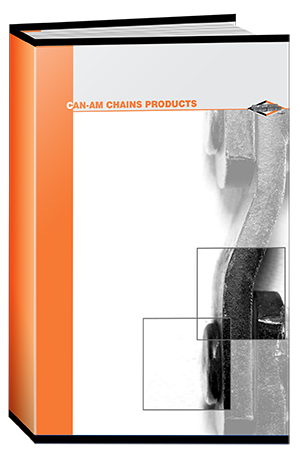Installation of New Chain into a Conveyor
Checklist for Conveyor Chain Install:
- The width of the trough need not be more than ½" wider, on each side, than the overall width of the chain including attachments. Chains should not wander from side to side.
- The wear strip must be full width of the conveyor so that the chain runs on the side-bar; the barrel of the chain should not support the chain.
- Chains that run in a trough should be at the correct height. Half the height of the sidebar is a good rule of thumb. If the chain is too low, the product on the chain will be slowed in movement. Conversely, a chain running too high in the trough can easily be forced out of the trough by side loads.
- The root line of the sprocket or drum should be approximately ½" above the level of the conveyor wear strip. This allows the chain to be lifted slightly as it contacts the sprocket. The benefit is immediate contact with the sprocket tooth, rather than 1/3 the way around the drum, and will improve chain life. A low root line relationship between the sprocket and wear strip causes the chain to be pulled down across the end of the wear strip. This causes premature wear on the sidebars and often, sidebar failure.
- Be certain the chain has the correct amount of slack on the return. A good rule of thumb for conveyor chain is 5 - 10% of the sprocket centers depending on the size and weight of the chain.
- Pay as much attention to the chain return as to load side. Use a trough if possible. If not, again, the correct amount of slack is important. Too much slack can cause the chain to sway or jump - a condition that increases chain wear.
- When installing sprocket assemblies it is critical to ensure the sprocket is aligned to the conveyor. Slight misalignment will result in uneven loading on the sprocket tooth face and chain barrels.
- When aligning the sprocket assembly the first check is ensuring Positive Lift then measure to ensure the position on the left side and the right side are exactly the same. This is to ensure the sprocket is in the correct position to the conveyor. After 1 – 2 weeks operation visual checks should be made to ensure there is no uneven wear on the conveyors chain barrels or the sprocket tooth face.
- The last step is never to be forgotten for successful operation. Breaking in a new chain is a very important procedure. The chain should be run, no load, for a few hours (6-8). This will smooth up the chain running surfaces as well as the wear strip and the sprocket tooth face. It is advisable to have a film of clean water on the chain during the break-in period and for that matter all the time. This procedure also allows the leading side of the rivet to polish up and "seat" properly in the I.D. of the barrel. Water is an excellent lubricant because it will carry away the dirt generated by the chain rubbing the wear strip and sprocket. Use a fire hose to wash down during the first hour then fine spray on the tail end is enough.







